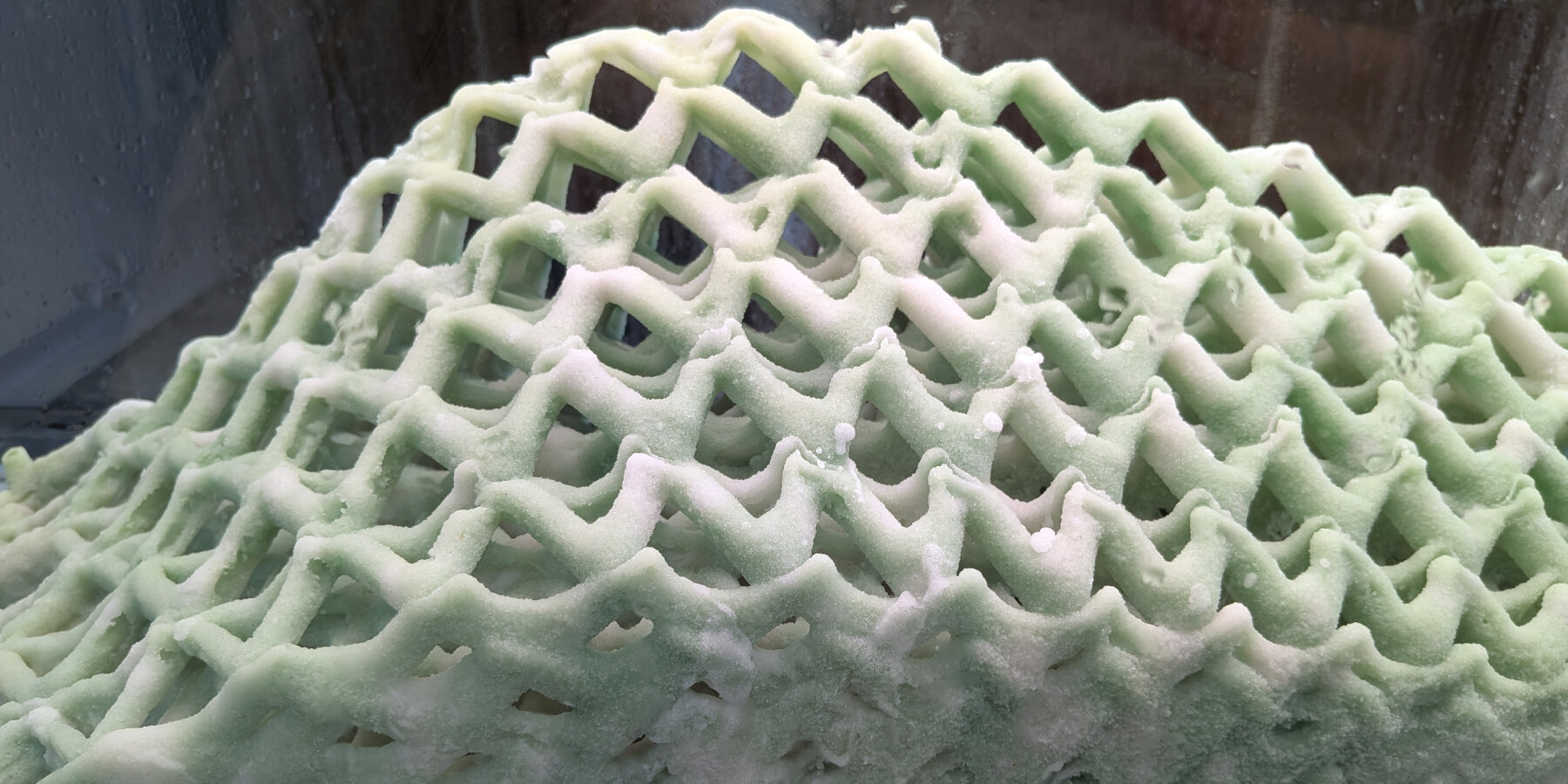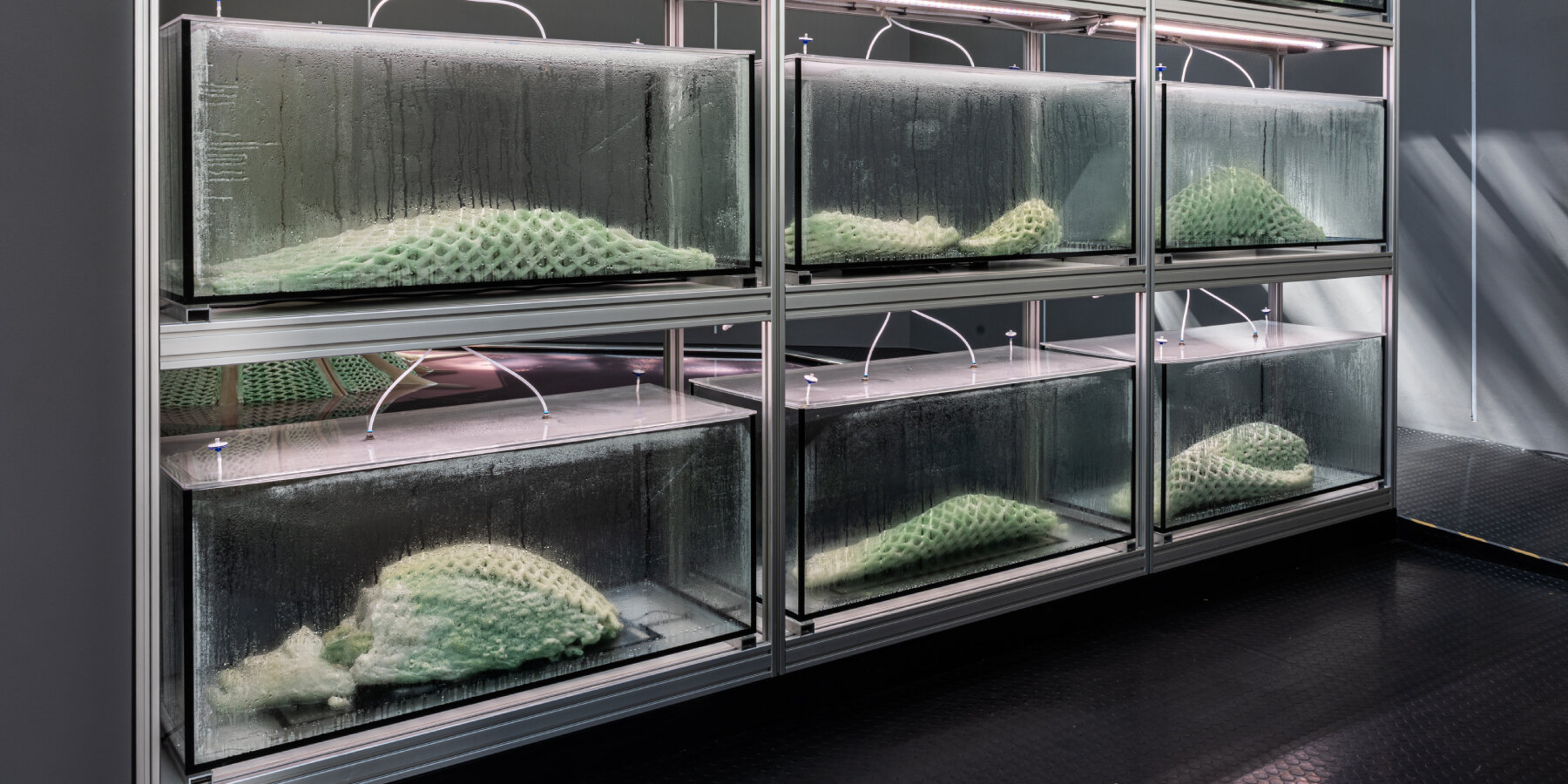3D printed biostructures with live cyanobacteria in venice
Living Room Collective uses live cyanobacteria within 3D printed biostructures to capture carbon dioxide from air in the Canada Pavilion at the Venice Architecture Biennale 2025. Named Picoplanktonics, the exhibition commissioned by The Canada Council for the Arts is on view from May 10th to November 26th, 2025. designboom speaks with Living Room Collective’s lead and biodesigner Andrea Shin Ling about the project. In our interview, she says that architecture often uses the term ‘regenerative design’ when referring to circular or upcycled material systems. ‘In Picoplanktonics, we are talking about the biological definition of regeneration, which means the literal ability to regenerate or renew from damaged or dead parts,’ she tells designboom.
The research team has merged two ancient metabolic processes for Picoplanktonics: photosynthesis and biocementation. For the former, they turn to cyanobacteria, one of the oldest groups of bacterial organisms on the planet. ‘Cyanobacteria are among the first photosynthetic organisms and are believed to be responsible for the Great Oxygenation Event, where 2.4 billion years ago, the atmosphere transformed from a high CO2 environment to a high O2 environment because of photosynthesis,’ Andrea Shin Ling explains. They can also produce biocementation, or the process of capturing carbon dioxide from air and turning it into solid minerals, like carbonates. Because of this, the resulting minerals act like ‘cement’ and can store the carbon permanently, keeping it out of the atmosphere.

all images courtesy of The Living Room Collective | photos by Valentina Mori, unless stated otherwise
Infusing the bacteria during the printing stage
Before bringing them to Venice, Andrea Shin Ling and the Living Room Collective fabricated the 3D printed biostructures at ETH Zürich’s laboratory. The biodesigner shares with us that when they make these structures, they already infuse the living cyanobacteria during the printing stage instead of later on. Then, they need to let the bacteria grow and take care of them so they can grow. This means they have to provide enough light, warmth, and humidity so that they can proliferate and slowly harden the prints.
‘The idea is that the bacteria cooperate in a human-initiated fabrication process and, with our care, can continue and finish that process (in this case, hardening the printed structures they live in),’ says Andrea Shin Ling. She adds that for the 3D printed biostructure with live cyanobacteria in Venice, favorable conditions mean warm sunlight, high humidity, and access to salt water. ‘These are conditions that are common in Venice and achievable in the Canada Pavilion, which informed our design process,’ the biodesigner explains to designboom.

Living Room Collective uses live cyanobacteria within 3D printed biostructures to capture carbon dioxide from air
Microorganisms that can repair themselves to a healthy state
In Picoplanktonics, the Living Room Collective works with bacteria as the living component of their material system. It has the ability to grow and die within the 3D printed biostructures, as shown in Venice, and the colony can restore itself under favorable conditions after periods of decline. Andrea Shin Ling says, however, that the process isn’t necessarily consistent since it depends on the environmental conditions at a particular point in time.
‘So, for instance, a bioprint might dry out if the air is too dry that week, and many of the bacteria die. But because the system is regenerative, the bacteria population has the potential to restore itself when favorable conditions return and then continue their carbon sequestration work,’ she shares with designboom.

these biostructures are inside the Canada Pavilion at the Venice Architecture Biennale 2025
During their research process, the group has also had samples where the bacteria have gotten ‘sick’, worn out, or where they looked like they were over-oxidized. With some care, the live cyanobacteria were able to repair themselves back to a healthy state. This is what Andrea Shin Ling means when she describes regenerative design. It looks more into the potential of biological material systems that are dynamic and restorative.
‘But their responsivity can also create situations that we don’t want. So much of the project is then trying to understand what is causing these situations and monitoring conditions so that we can respond accordingly,’ the biodesigner adds. Visitors to the Venice Architecture Biennale 2025 can see the research process and progress of Picoplanktonics firsthand inside the Canada Pavilion. It remains on-site from May 10th to November 26th, 2025.

the research group takes care of the bacteria throughout the exhibition to maintain their healthy state

the bacteria need warm sunlight, high humidity, and access to salt water to thrive

the research group already infuses the living cyanobacteria during the printing stage | image © designboom

the bacteria harden the printed structures they live in | image © designboom

the research team has used ancient metabolic processes for Picoplanktonics | image © designboom

the cyanobacteria can also produce biocementation, or the process of capturing carbon dioxide from air

Living Room Collective’s lead And biodesigner Andrea Shin Ling

the exhibition is on view until November 26th, 2025
project info:
name: Picoplanktonics | @picoplanktonics
group: The Living Room Collective
team: Andrea Shin Ling Nicholas Hoban, Vincent Hui, Clayton Lee
commission by: The Canada Council for the Arts | @canada.council
event: Venice Architecture Biennale 2025 | @labiennale
location: Calle Giazzo, 30122 Venice, Italy
dates: May 10th to November 26th, 2025
research and development: Andrea Shin Ling, Yo-Cheng Jerry Lee, Nijat Mahamaliyev, Hamid Peiro, Dalia Dranseike, Yifan Cui, Pok Yin Victor Leung, Barrak Darweesh
photography: Valentina Mori | @_valentinamori_
production
eth zurich: Huang Su, Wenqian Yang, Che-Wei Lin, Sukhdevsinh Parmar; Tobias Hartmann, Michael Lyrenmann, Luca Petrus, Jonathan Leu, Philippe Fleischmann, Oliver Zgraggen, Paul Fischlin, Mario Hebing, Franklin Füchslin; Hao Wu, Nicola Piccioli-Cappelli, Roberto Innocenti, Sigurd Rinde, Börte Emiroglu, Stéphane Bernhard, Carlo Pasini, Apoorv Singh, Paul Jaeggi; Mario Guala, Isabella Longoni;
toronto metropolitan university: Venessa Chan, Minh Ton, Daniel Wolinski, Marko Jovanovic, Santino D’Angelo Rozas, Rachel Kim, Alexandra Waxman, Richard McCulloch, Stephen Waldman, Tina Smith, Andrea Skyers, Randy Ragan, Emma Grant, Shira Gellman, Mariska Espinet, Suzanne Porter, Stacey Park, Amanda Wood, Lisa Landrum, Dorothy Johns, Cedric Ortiz
university of toronto: Daniel Lewycky, Philipp Cop
visualisation: Adrian Yu, Nazanin Kazemi, Ariel Weiss
structural advisors: Andrea Menardo, Kam-Ming Mark Tam
graphic design: Shannon Lin
website: Sigurd Rinde, Shannon Lin
local project logistics: Tamara Andruszkiewicz
project advisors: ETH Zurich, Benjamin Dillenburger, Mark Tibbitt
support: Canada Council, Digital Building Technologies, Institute of Technology & Architecture, D-ARCH, ETH Zurich, Department of Architectural Science, Toronto Metropolitan University, John H. Daniels Faculty of Architecture, Landscape and Design, University of Toronto, Royal Architectural Institute of Canada; Advanced Engineering with Living Materials (ALIVE) Initiative, ETH Zurich; Additive Tectonics GmbH; ABB Switzerland; Vestacon Limited and NEUF Architect(e)s
The post 3D printed biostructures with live bacteria capture carbon dioxide from air at venice biennale appeared first on designboom | architecture & design magazine.